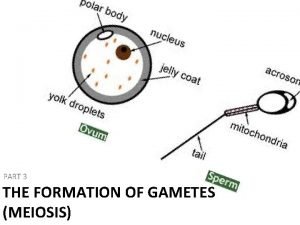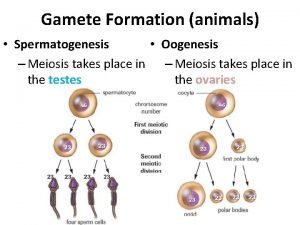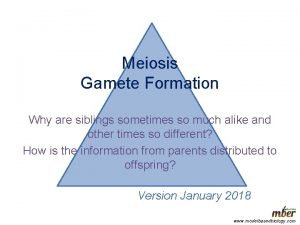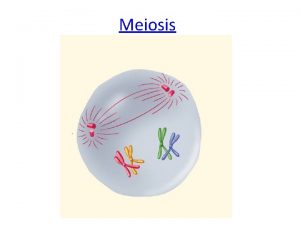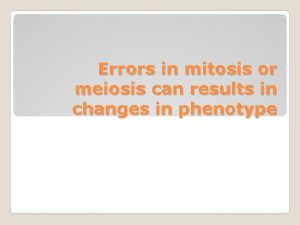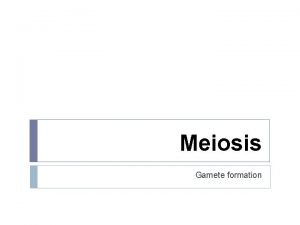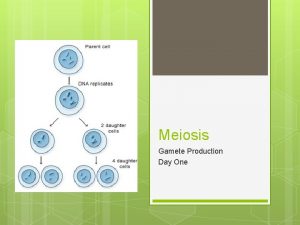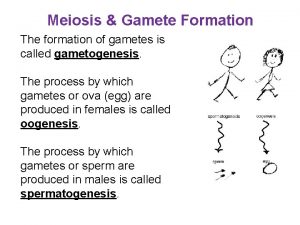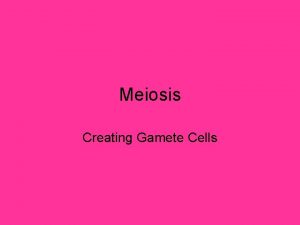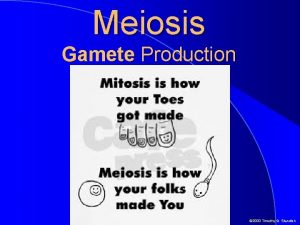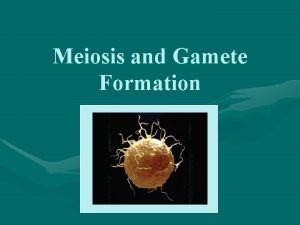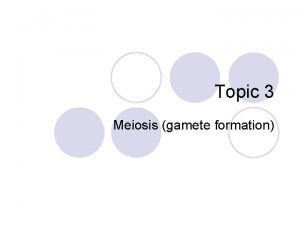GAMETE FORMATION AND ERRORS IN MEIOSIS GAMETE FORMATION










- Slides: 10

GAMETE FORMATION AND ERRORS IN MEIOSIS

GAMETE FORMATION • Gametogenesis – process of creating sperm and eggs • Spermatogenesis – male gamete formation • Occurs in the testes • Immature spermatogonia (germ cells) may continually duplicate through mitosis or undergo meiosis to eventually develop into sperm cells • In some species this can occur year round while in other species this is limited to certain times in the year

SPERMATOGENESIS • A diploid germ cell (spermatogonium) undergoes meiosis to create 4 haploid cells • Following meiosis II, most cytoplasm is lost and a tail develops to allow locomotion sperm • The entire process, from spermatogonium to functional sperm, takes approximately 76 days • At any one time, different cells may be in a different stage of the development process this allows sperm cell production to stay steady at about 200 million sperm per day

GAMETE FORMATION • Oogenesis – female gamete formation • Occurs in the ovaries • Diploid germ cell (oogonium) undergoes meiosis to create 1 haploid cell • After meiosis I, cytoplasm does not split equally and the majority goes to the secondary oocyte. The other cell is called a polar body and it is not a viable sex cell. • After meiosis II, the cytoplasm is again unequally divided and only one cell is viable as a sex cell (egg or ovum)

OOGENESIS • When a female is born, primary oocytes have already entered meiosis I but remain suspended in prophase I until puberty • Starting at the first menstrual cycle, meiosis will resume one oocyte at a time, once a month • Production of ova continues from puberty until menopause (between 40 and 55) • Oocytes left in ovaries nonfunction/unresponsive and no longer released

ABNORMAL MEIOSIS • Nondisjunction – failure of chromosomes to separate properly • 2 homologous chromosomes move to the same pole during meiosis • One of the daughter cells will be missing 1 chromosome, while the other retains an extra chromosome

NONDISJUNCTION • In humans, nondisjunction produces gametes with 22 and 24 chromosomes • The gamete with 24 chromosomes has both chromosomes from one of the homologous pairs • If joins with normal gamete, 24 + 23 = 47 chromosomes in zygote rather than 46 • Once zygote begins dividing, each cell of the body will contain 47 chromosomes • Trisomy: there are 3 homologous chromosomes instead of a homologous pair • Monosomy: there is a single chromosome instead of a homologous pair

DOWN SYNDROME • A trisomic disorder in which a zygote receives 3 homologous chromosomes for chromosome pair number 21 • Common traits: round, full face, enlarged and creased tongue, short height, large forehead, mental retardation • Woman in 40 s has 1 in 40 chance of having a child with Down syndrome • 1/600 babies

• Turner syndrome: monosomic disorder - a female has a single X chromosome • Sex chromosomes undergo nondisjunction • Appear female but do not usually develop sexually, short and have thick, widened necks 1/3000 female babies • Klinefelter syndrome: trisomic disorder - male carries an XXY condition • Nondisjunction in sperm or egg • Appears to be male at birth, but begins producing high levels of female sex hormones once entering sexual maturity Males are sterile • 1/500 male babies

 When does crossing over occur
When does crossing over occur Gamete production
Gamete production Ispindle
Ispindle Lucy and maria twins
Lucy and maria twins Chromosomes form tetrads during
Chromosomes form tetrads during Edward syndrome
Edward syndrome Concept mapping chapter 10 meiosis 1 and meiosis 2
Concept mapping chapter 10 meiosis 1 and meiosis 2 Differences between mitosis and meiosis
Differences between mitosis and meiosis Section quick check chapter 10 section 1 meiosis answer key
Section quick check chapter 10 section 1 meiosis answer key Chapter 10 meiosis 1 and meiosis 2 answer key
Chapter 10 meiosis 1 and meiosis 2 answer key 11/15
11/15
